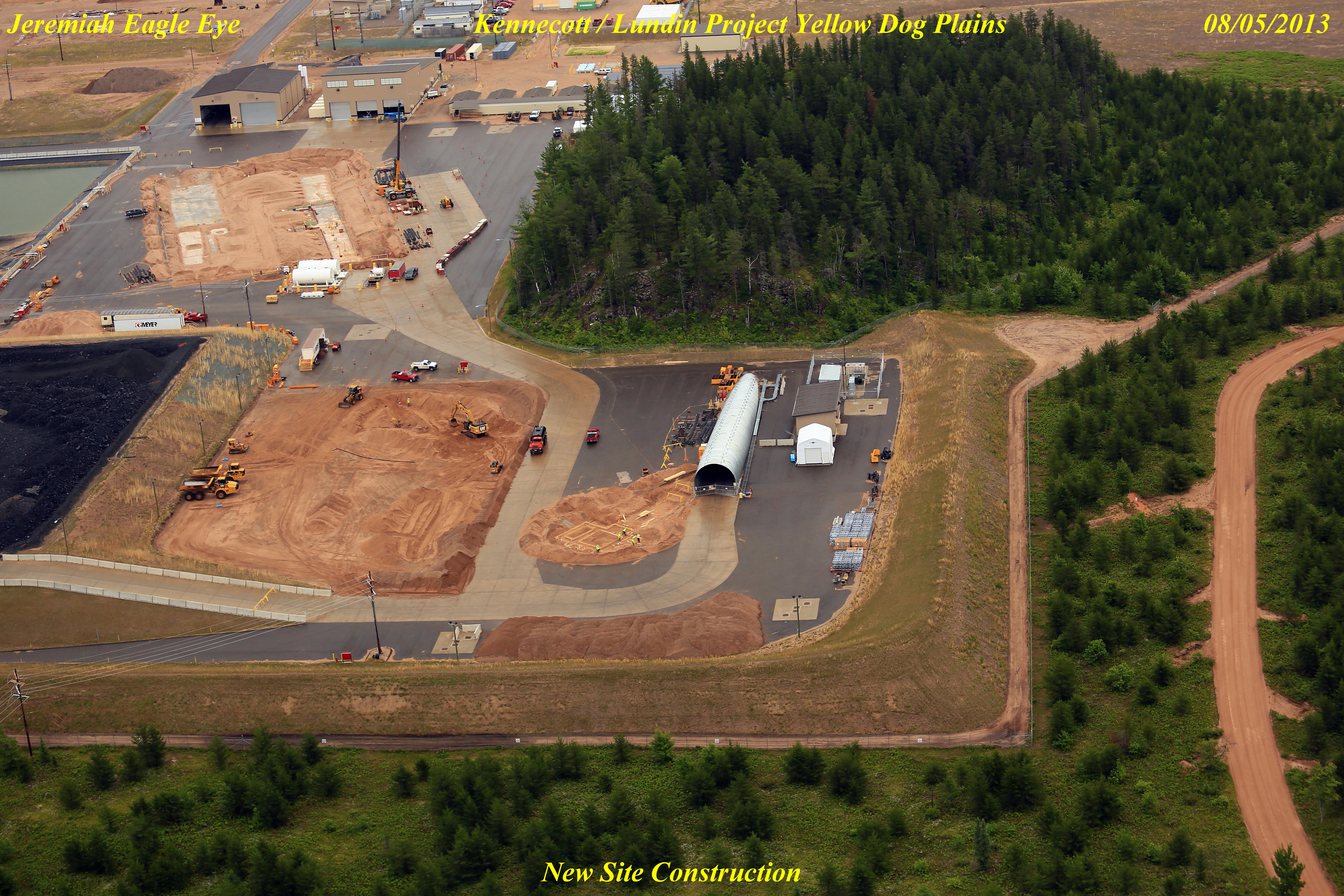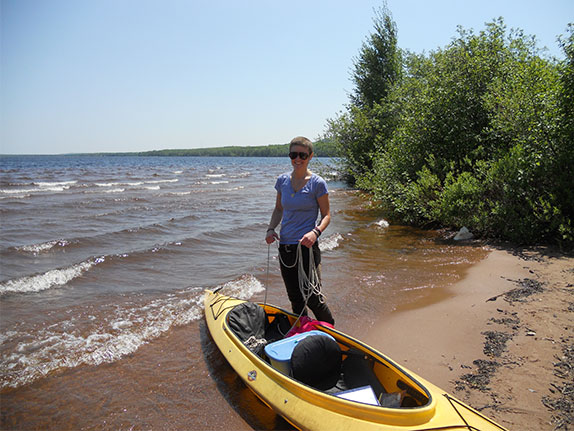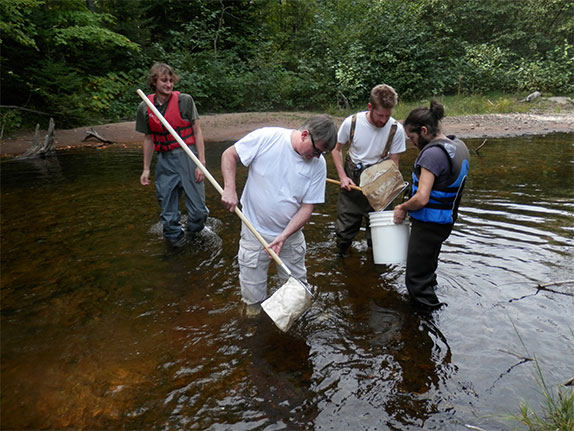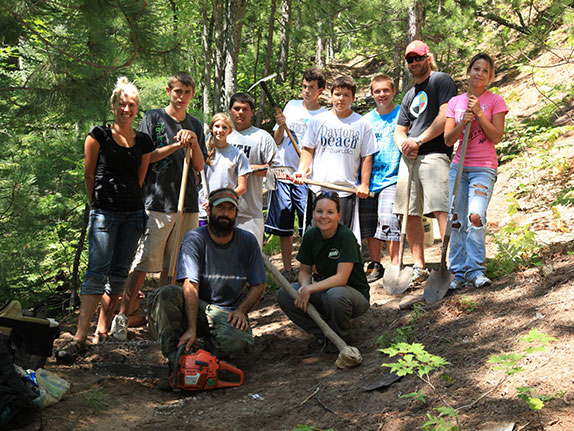
History
of the Eagle Mine
Yellow Dog Plains has been explored for minerals since the 1970’s by the USGS. In the early 1990’s, mineral companies began leasing state owned land and minerals from the Michigan Department of Natural Resources. They developed relationships with the largest land owners in the area and developed a safe platform to begin exploring for minerals. It became clear to the communities of this area in 2002 that interest in this area was very high.
In 2003, the Yellow Dog Watershed Preserve met with Kennecott Minerals to discuss the company’s intention. It became known that the interest was due to an ore body that contains high grade nickel and copper deposits, worth approximately $5 to $10 billion. To extract this type of ore, a process commonly known as sulfide mining would need to be used. The ore body lies directly under the Salmon-Trout River in a watershed directly adjacent to the Yellow Dog River and concerns immediately began to arise about the impacts should mining occur. Our organization contacted the National Wildlife Federation and developed a partnership to take a closer look at the safeguards our government had to protect the watershed from sulfide mining.
In 2004, Governor Granholm created a workgroup to talk about possible new legislation that would provide increased protection if mining occurred. The workgroup, comprised of the Yellow Dog Watershed Preserve, environmental groups, industry, the Department of Natural Resources, Michigan Department of Environmental Quality, and Kennecott, formulated Part 632. This legislation introduced a new permitting process, safeguards on mining, and outlined recourse for all parties. It was passed in December 2004.
In February 2006, Kennecott Minerals applied for five permits: Air discharge, Groundwater discharge, Mining, Land Use lease, and Exploration lease. The Michigan Department of Environmental Quality (MDEQ) deemed it complete after ten days of reviewing 7000 pages. In objection to this obvious skimming over of the application, the National Wildlife Federation took the matters to the court. During the court process, the MDEQ issued a list of 91 technical deficiencies in the application to Kennecott. After two court cases and one appeal, the legal system found that we were not aggreived by the situation, allowing Kennecott to move forward. The company replied to the deficiencies and a public commenting session was held. Over 700 community members spoke in opposition to the mining prospect and the application.
Still, the MDEQ issued a preliminary approval of the permits in January 2007. Shortly after, documents that had been suppressed by the MDEQ were uncovered and brought to light. The suppressed documents were technical reports emphasizing that the company’s plan to prevent subsidence (caving in) of the crown pillar as not reflecting best industry standards. The permitting process came to a halt and an internal investigation of the MDEQ took place.
In July 2007, the MDEQ determined that they were not at fault and reissued the preliminary approval. On December 14, 2007, a final approval was given for three permits. In response, Yellow Dog Watershed Preserve, National Wildlife Federation, Keweenaw Bay Indian Community, and the Huron Mountain Club filed two contested cases and one lawsuit against the MDEQ. The basis of the injunctions is that MDEQ granted approval to an application that did not meet the criteria of Part 632. The two other permits were needed from the MDNR to have all state permits in hand.
In January 2008, MDNR didnot grant the permits at their monthly meeting but instead asked the company to supply more information. Kennecott responded by elaborating on issues that were of concern to the MDNR and the permits were approved in February 2008. However, the MDNR stipulated that they will not sign the final approval until the company has no impending lawsuits and has acquired a federal permit from the U.S. Environmental Protection Agency. This permit is called an Underground Injection Control permit and it is needed because of groundwater concerns.
Kennecott supplied an application to the U.S. EPA for a UIC permit but then withdrew it once it was known there were concerns about their plans. They then redesigned the Treated Wastewater Injection System so that water would not be directly injected into the groundwater but rather directed to the surface and let percolate into the ground. This detail allowed the company to skirt any federal involvement at that point and thus they had all permits in hand.
Construction on state land began in the spring of 2010. The overall injustice of the permitting system sparked numerous attempts by community members to halt activity by non-violent civil disobedience. A local woman was arrested in April of 2010 after being asked to move from Eagle Rock then refusing. Cynthia Pryor’s arrest then inspired others to do similar acts. Within a week, groups of people had staged an occupation of Eagle Rock and stayed their for months. Finally the company asked the police to come out and forcefully remove the protesters so they could continue construction. Both Native Americans and non-native community members were removed and two natives were arrested for occupying land within their ceded territory.
Efforts to halt construction before irreprable damage is caused continued when the four co-petitioners filed an appeal through the State of Michigan court system. The Michigan Court of Appeals agreed in 2012 to hear the case regarding the 2007 decision to issue the mining and discharge permits to Kennecott Minerals. The date for oral arguments was set for June 3, 2014. Over 500 tribal members from the Keweenaw Bay Indian Community attended the hearing in Lansing and staged a demonstration on the steps of the courthouse. On August 13, 2014 the Michigan COA affirmed the lower court’s decision to allow the Lundin Eagle Mine to move forward into production sometime during the fall 2014.

In Summer 2013 the mine was sold by Rio Tinto to Lundin Mining Company based in Canada. The new ownership is smaller and less experienced, although they are also a multinational conglomerate company with operations in Finland, Spain, Portugal, Sweden, and the Democratic Republic of the Congo.
So what’s the big deal anyway?
Environmental Risks
Acid Mine Drainage- AMD is a serious consequence of this type of mining. The ore lies in sulfide bearing rock and once extracted, could produce AMD through a series of chemical reactions. The sulfide rock left as “waste rock” would sit in a large pile and naturally be exposed to the two components that would start the chemical sequence, air and water. There is no way to prevent air from interacting with the sulfide rock. The company has measures to reduce exposure to water, but are not adequate since this is a water rich area. AMD, once introduced into the ecosystem, acts as a solvent and takes heavy metals along with it to the waterways. This is a major concern and rightly so. AMD has poisoned over 18,000 miles of river in the U.S. alone.
Water Pollution- Acid Mine Drainage could severly impact the ability of the Salmon-Trout River to absorb pollution. Heavy metals could leach into the food chain and wreak havoc on this small trout fishery. Also of concern is the placement of pumps and the amount of water permitted already to be withdrawn from the stream. The MDEQ has permitted the company to withdraw 10,000 gallons every other day from a stream that is 3ft wide and 1.5ft deep.
Air Pollution-The potential mining operation plan calls for scrubbers and other particle collecting mechanisms in the crushing facility to reduce the amount of sulfide dust entering the air. However, there are no such mechanisms for the mining ventilation shafts that will surely allow dust to escape. These particles can move far beyond the reach of the “impacted area” and move towards the population or other rivers, particularly the Yellow Dog River.
Groundwater- The aquifer in this area is known to be the largest recharging aquifer in the midwest. Plans to taint the aquifer with mine waste water, although treated, would still degrade the quality of the water. Currently, the company is seeking a permit to do this from the U.S. EPA, who knows Kennecott as their 3rd worst polluter.
Endangered Species- The Kirtland’s warbler was sighted near the potential mine site and immediately became a concern. Sightings have been confirmed but no nesting pair is known to the area and therefore, the company does not have to consider altering the mining plan. The Coaster Brook Trout is documented to naturally spawn in the Salmon-Trout River which will be directly impacted. This species is still not considered separate from river brook trout by the U.S. Fish and Wildlife Service but steps have been made to do this. Click here for more info about these species.
Subsidence- Until just recently, January of 2008, Kennecott did not have any mechanisms for monitoring subsidence if the project goes through. The area between the Salmon-Trout River and the mining shaft is 1000ft. If subsidence occurs, the river will be severly impacted. After the MDNR asked them to submit a monitoring plan, the company included in the application that they will measure once a month in four spots throughout the entire affected area. Post closure monitoring will be reduced to twice a year.
Development of a Wilderness-This area is known for its wildness and solitude. It could all end with the sound of drilling, vehicles, facility operations, and more. The company has contracted to have power lines run out there, although underground. This all would completely change the state of the land.
Economic Risks
Boom and Bust- When service jobs are built up around an industry, they rely upon that industry to keep them alive. When the mine shuts down after 7 years, the service jobs will not have a source of commerce once again. All businesses and employment reliant upon the mine will shrink as they always have after the main employer shuts down. For example, in Flambeau, the company built the town a library and purchased all of the books. However, once the company shut the mine down, the library had no source of funding other than this temporary interest of a multi-national corporation and was forced to close as well. Now only the empty building stands. The company has already made many alluring promises to the local communities, including Kennecott libraries.
Employment and Operation Lifespan- Kennecott is promising around 100 jobs to staff the mine and claims 75 of those will come from the local communities. The mine life span is expected to be for 7 years. This could be a hopeful projection, however, considering the last mine the company operated closed in 4 years. We will never know for sure how long it will be open for and exactly how many “local people” will fit their demand for technology employees.
Royalties and Taxes- The local townships have been promised hundreds of thousands in taxes. The State will receive 8% of the royalties. If one compares the value being extracted and absorbed elsewhere, it is obvious this is a pittance of the true value of the public’s minerals. The local tax base also fluctuated very high for the local communities and actually turned into tax hikes for the citizens in Flambeau.
Financial Assurance- The law requires a sum of money to be set aside by the company in case an environmental disaster occurs after they have left the community. This financial assurance was set at $10 million. However, funds for cleaning up polluted rivers are generally much higher. For instance, the MDEQ spent $25 million cleaning up a small section of the Kalamazoo River in Lower Michigan. The financial assurance left by the company will not be enough to offset the burden.
Social Risks
State Owned Land- The company and the State of Michigan declare that a parcel of publicly owned land is the best location for the mining facilities. Kennecott applied for a permit to fence of 120 acres of public land to build their crushing facility, rock storage facility, and waste water building. The State recently granted them this permit even though this much land has never been removed from public access for this long in the state’s history, 120 acres for 40 years. This area is used for recreation, hunting, and camping and will no longer be accessible to those who have used it for so many years.
Cultural Aspects- Artifacts of historical native significance have been found near the facility site on a large outcrop called Eagle Rock. The company declared it was not significant so this was not a concern to the State. When third parties such as the Keweenaw Bay Indian Community and the Yellow Dog Watershed Preserve contested this to the state, they replied by granting another opportunity for the company’s privately hired consultants to take another look. They never did. The tribe will also be prohibited from using their legally ceded territory for hunting and fishing. The land that is will be fenced off is tribal hunting land and the state did not consider this when granting the permits.
Transportation- It is estimated that during peak operations of the mine, over 200 trucks bearing ore will be making the drive to the nearest railhead. After the rejection of the County Road 595 plan by the EPA, the company will use County Road Triple A, County Road 510 and County Road 550. All of the local residents use these roads to travel to their camps and to and from Big Bay and there are concerns about truck speed, collisions, noise, and wildlife. The roads will be widened and straightened to never again resemble the quaint roads through wilderness that once were there.
Health- One hundred and forty physicians signed a document stating their opposition to this mine due to health concerns. As mentioned above, sulfide particulates will undoubtedly be sent into the air and will travel where ever the wind blows. These particles in the air we breathe would impair our respitory systems. The physicians are also concerned with potential contamination of drinking water for local communities and rural residents.
Demographics-Temporary populations of workers will potentially move into our community. In other areas that have experienced similar occurances, crime rates and juvinile delinquency often follow. Again the services would expand to fill their needs, only to shrink once the workers move on. Already people from out of state have moved nearer to work on preliminary drilling, etc. Our small community of 270 people could be changed for the worse.
Recent Posts

30th Anniversary Celebration
26 Jun, 25

2025 Fly-fishing Workshop on the Yellow Dog
11 Jun, 25

2025 Bentley Trail Ski & Snowshoe Event
07 Feb, 25

2024 Annual Meeting and Hike, 10/26
07 Oct, 24






